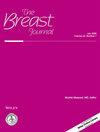The continued role of intraoperative assessment of the surgical margins in lumpectomy samples.
IF 1.9
4区 医学
Q3 OBSTETRICS & GYNECOLOGY
引用次数: 0
Abstract
Currently, breast conservation therapy that includes removal of the primary tumor of the breast by lumpectomy followed by adjunct radiation is a preferred treatment for majority of breast cancer patients.1,2 This practice, however, requires the ability to obtain negative lumpectomy margins to balance between optimal local control of the tumor and minimal tissue resection.3 Obtaining clear surgical margins are found to be important for local control as positive surgical margins increase local recurrence rate by at least twofold.4– 6 Studies have demonstrated that as positive surgical margins are associated with higher rate of local recurrence and the need for a second return to the operating room for the reexcision of positive margins, measures should be in place to avoid this process. In addition, it is critically important to follow the established national guidelines in respect to the accepted definition of an adequate margin. Based on 2014, and 2016 consensus statements offered by the Society of Surgical Oncology and the American Society of Radiation Oncology, adequate surgical margin is defined as no tumor at ink for invasive breast cancer and a 2mm tumorfree margin adequate for ductal carcinoma in situ.7,8 In order to avoid a second surgery and the associated cost and anxiety to breast cancer patients undergoing lumpectomy, it is important to consider providing an intraoperative assessment of surgical margins. This requires an accurate and costeffective rapid intraoperative technique that would evaluate surgical margins and allow for realtime reexcision to be perform if necessary.9,10 There are two alternatives to provide an intraoperative consultation. The most traditional approach has been the frozen section analysis. This approach has shown to minimize reoperation rates.11– 17 In a recent study reported by Racz et al.,18 the use of intraoperative frozen section pathologic evaluation of margins in patients undergoing lumpectomy has resulted in an extremely low reoperation rate of <2%. Similarly, in the study reported by Akrami et al.19 published in the current issue of The Breast Journal, the authors report the low rate of 2.3% positive surgical margins among 4843 patients enrolled in this study. The authors attribute the low rate of the positive margins in their study to the use of the intraoperative frozen section consultation in their practice. There is, however, a trend that has made the use of intraoperative consultation by frozen sectioning less frequent with dependence only on the final permanent section diagnosis of surgical margins. This may be the result of frozen sections being considered labor intensive, expensive and technically difficult to freeze and cut adipose tissue.20– 22术中评估乳房肿瘤切除标本的手术边缘的持续作用。
本文章由计算机程序翻译,如有差异,请以英文原文为准。
求助全文
约1分钟内获得全文
求助全文
来源期刊

Breast Journal
医学-妇产科学
CiteScore
4.00
自引率
0.00%
发文量
47
审稿时长
4-8 weeks
期刊介绍:
The Breast Journal is the first comprehensive, multidisciplinary source devoted exclusively to all facets of research, diagnosis, and treatment of breast disease. The Breast Journal encompasses the latest news and technologies from the many medical specialties concerned with breast disease care in order to address the disease within the context of an integrated breast health care. This editorial philosophy recognizes the special social, sexual, and psychological considerations that distinguish cancer, and breast cancer in particular, from other serious diseases. Topics specifically within the scope of The Breast Journal include:
Risk Factors
Prevention
Early Detection
Diagnosis and Therapy
Psychological Issues
Quality of Life
Biology of Breast Cancer.
 求助内容:
求助内容: 应助结果提醒方式:
应助结果提醒方式:


